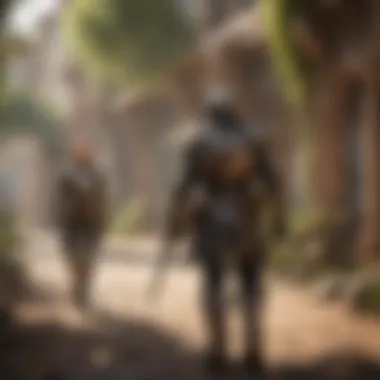Explore the Top Free MMORPGs That Defined 2021


Intro
As the gaming landscape evolves, free-to-play MMORPGs continue to captivate players around the globe. In 2021, numerous titles stood out, catering to the diverse needs of gamers. These games not only provide invaluable entertainment but also foster engaging communities and social interactions.
In this article, we will present a thorough overview of the best free MMORPGs, analyzing their gameplay mechanics, community engagement, and visual aesthetics. By examining player experiences and industry updates, we aim to uncover what makes these games both attractive and successful within the ever-expanding role-playing genre. By the end of this overview, readers will better understand the integral features and characteristics that define top MMORPGs of 2021.
News Updates
In 2021, several exciting developments shaped the MMORPG scene. Notable announcements kept the gaming community buzzing, as updates and expansions hit the markets.
Some of the notable updates include:
- New Expansions: Popular games like Genshin Impact and World of Warcraft: Shadowlands announced expansion packs that greatly enhanced their content.
- Special Events: Games rode successful crossovers with well-known franchises or livestreamed charity events, captivating dedicated players and attracting new ones alike.
- Upcoming Titles: Many anticipated releases captured gaming enthusiasts' attention.
There was particularly significant interest surrounding the announcement of Elyon by Bluehole Studio, which promises unique class dynamics and dynamic castle sieges.
The ongoing Gamescom 2021 conference was another highlight, hosting various developers sharing insights on upcoming game content, technology advancements, and industry trends. Players eagerly await what the future holds, especially with upcoming events scheduled for late 2021 and early 2022.
"Updates not only enhance gameplay but also contribute to long-term engagement by refreshing the game experience."
Reviews and Recommendations
A careful examination of MMORPG offerings from 2021 reveals a few standout titles. Each game has its strengths, catering to different player preferences. The following provides an overview of the most significant contenders:
- New World: This open-world title from Amazon Games offers vast exploration, resources gathering, and diplomacy-based player interactions.
- Guild Wars 2: Reigniting player interest with seasonal updates, the game keeps expanding its captivating lore.
- Genshin Impact: Merging MMORPG elements with action gameplay, it captivates audience with its stunning visuals and immersive world.
These titles earned recognition through their gameplay mechanics and community involvement, proving that player feedback is crucial in shaping immersive experiences.
In reviewing these MMORPGs, we emphasize the following important Factors:
- Visual Appeal: Exceptional graphics draw players into rich worlds.
- Community Engagement: Games with vibrant communities tend to retain players better.
- Gameplay Mechanics: Varied mechanics and dynamic systems deliver repetitively engaging content.
Tips and Tricks
As players explore MMORPGs, understanding certain strategies and techniques enhances their overall experience. A few general tips include:
- Join Communities: Connecting with others in Discord or Reddit helps uncover tips on game features and meet fellow enthusiasts.
- Experiment with Classes: Trying different character classes often unveils playstyle preferences and unique game mechanics.
- Keep an Open Mind: Evolving games offer changing dynamics. Being adaptable allows one to seize new game opportunities.
For those eager to improve gameplay experiences, various guides exist for strategic content or character progression satisfying the high skill demands MMORPGs pose.
Trending Topics
In 2021, certain trends distinguished themselves within the gaming community. Major topics of discussion shifted around:
- Social Dynamics: Players increasingly pursued the social aspect, pressing game developers to prioritize community focus and cooperation features.
- In-game Monetization: Discussions frequently arose over inflation and ethical microtransactions in free-to-play models.
These trends dictate current player preferences and influence future gaming developments. Analyzing what topics generate significant buzz helps creators and players alike integrate evolving demands into their formats.
In crafting an immersive gaming landscape, acknowledging game trends is paramount in delivering user-centric design decisions. As MMORPGs continue improving, close monitoring of these shifting narratives enhances overall player experiences.
Prelude to MMORPGs
The realm of MMORPGs, or Massively Multiplayer Online Role-Playing Games, presents a complex landscape of interactive and expansive gaming experiences. As many enthusiasts seek to understand this dynamic genre, it becomes crucial to explore its foundations, evolution, and contemporary significance, particularly focusing on the growth of free-to-play models.
Defining MMORPGs
At its core, an MMORPG merges gaming with social interaction. It provides a persistent online world where thousands of players engage in quests, battles, and various skill sets, creating connections that often span geographic boundaries. These games typically include a combination of character development, exploration, and community building, allowing users to craft unique narratives from shared experiences. The defining characteristic of MMORPGs lies in their ability to maintain world continuity while enabling real-time interaction among various online participants.


The Evolution of MMORPGs
The journey of MMORPGs began in the early 1970s, with the inception of text-based MUDs (Multi-User Dungeons). Over decades, technical advancements and player demand propelled the genre into a thriving online platform. The rise of graphical interfaces in the late 1990s introduced titles like EverQuest, leading to widespread popularity. Today, hallmark games such as World of Warcraft, Guild Wars, and Final Fantasy XIV showcase steadily improving visuals, complex game ecosystems, and evolving narratives. This ongoing development illustrates how MMORPGs adapts to new technological landscapes and player expectations.
Importance of Free-to-Play Models
Monetization strategies have shifted dramatically, especially with the rise of the free-to-play model. This practice has rendered games accessible to a broader audience by eliminating high entry costs usually associated with premium titles. Players can experience core elements without financial barrier while the developers maintain revenue through optional in-game purchases and expansions. This model enhances player engagement and retains a significant base of active users who partake in the community. Notably, it also permits new players to explore MMORPG landscapes at their own pace, making titles more inviting within a competitive gaming market.
Notable Features of Free MMORPGs
Free MMORPGs, or Massively Multiplayer Online Role-Playing Games, attract countless players with their unique attributes. These games extend beyond simple entertainment; they forge vast digital worlds where user interactions drive value. In this section, we will dissect what makes free MMORPGs stand out, including player accessibility, game mechanics, and community interaction. Understanding these nuances provides insights into their sustained popularity and the dynamics driving growth in this genre.
Accessibility and Player Base
Accessibility is a crucial feature of free MMORPGs. The absence of an initial monetary barrier invites players from diverse backgrounds into immersive worlds. Anyone with internet access and a compatible device can join the experience without spending money. This approach results in a larger and more diverse player base, promoting inclusivity.
Another aspect of accessibility includes cross-platform support. Many free MMORPGs allow gamers to connect across different devices, be it PCs, gaming consoles, or mobile phones. Such versatility caters to various preferences, amplifying enjoyment and increasing engagement. Moreover, accessibility can lead to forming substantial user communities, where players can exchange strategies and experiences.
Often, free MMORPGs will use a freemium model. Through this strategy, while the base game remains free, there are in-game purchases available that enhance gameplay. Understanding this structure becomes important since it shapes player investment and loyalty levels within the game.
Game Mechanics and Customization
Game mechanics in MMORPGs define how players interact with the game environment and each other. These mechanics range from combat to crafting, and many incorporate a unique blend of actions that set each game apart. Some titles focus intensively on PvP (player vs. player) engagements, while others might emphasize PvE (player vs. environment) with extensive quests and narrative.
Customization plays a significant role as well. Players often have the ability to design their characters and skill sets to suit personal preferences. This feature fosters a sense of individuality, enhancing enjoyment and commitment to the game. Some systems permit deep customization in crafting and building, allowing players to experiment with complex interactions.
In addition, having multiple build paths provides strategic depth to gameplay. Players can choose to navigate familiar routes or opt for unconventional pathways, which reshapes the gaming narrative and sustains engagement over time. This customization can exhibit itself differently in various titles, making reiteration open for exploration across diverse games.
Community Interaction
Community interaction is an underlying strength in free MMORPGs. These games are inherently social and rely on player collaboration. Players often form alliances, guilds, or clans to enhance their gaming experiences. This shared journey typically leads to forming lasting friendships and networks that extend beyond the game.
Various in-game features encourage interaction, such as chat systems, trading options, and group events. These tools amplify the social engagements and make coordinated efforts possible for difficult challenges, enhancing the collective experience.
An even broader conversation occurs when players extend their discussions outside the game environment. Platforms such as Reddit or dedicated forums allow players to discuss strategies and share experiences. Social media outlets further expand this dialogue. Using these platforms maintains buzz around games and continues to refine community support.
Ultimately, the dynamic nature of player interactions helps sustain one of free MMORPGs' most significant assets: a vibrant, engaged community. Understanding how these interactions drive gameplay informs both developers and players about the flourishing ecosystem in which these games exist.
Top Free MMORPGs of
The landscape of free MMORPGs has grown increasingly expansive and intricate. The focus here is on the transformative impact these games hold for the player base. In this section, we delve into three standout MMORPGs of 2021, detailing their gameplay mechanics, artistic directions, and community reactions. The analysis presented here is designed to aid players in understanding what distinguishes each title, facilitating a more informed choice for their gaming experience.
Game One: Overview and Features
Gameplay Highlights
This MMORPG offers unique features that resonate well with its audience. One major aspect is the combination of skill-based combat and engaging quests. Players experience real-time battles that require tactics over sheer power. This helps in retaining the interest as challenges escalate. Additionally, team play is emphasized, promoting collaborative gameplay that many find rewarding. Players often provide insight about the straightforward yet engaging mechanics, citing them as crucial to their enjoyment.
Art Style and Graphics
The visual presentation of this game sets it apart. The design showcases vibrant colors and a stylized approach, creating an inviting world. Many players appreciate the animation fluidity, which adds a dynamic quality to their interaction. However, some critiques suggest the art style may not appeal to purists who favor realistic graphics. Nonetheless, the choice of aesthetics serves well for broader audience engagement, contributing effectively to immersion.
Community Feedback
Community responses highlight the sense of belonging this game fosters. Players actively engage in various forums, discussing strategies and sharing accomplishments within the game. Review platforms frequently reflect positive sentiments regarding the community aspects. Nonetheless, concerns have been raised about toxic behaviors that can surface in competitive environments. Such feedback is significant since it reflects the social dynamics present in MMORPGs.
Game Two: Overview and Features
Gameplay Highlights


Another title stands out due to its questing structure. Players value the intricate narrative woven into gameplay. Immersive story arcs compel individuals to continually participate. The game employs a mix of exploration and grinding, offering levels of engagement that span mere combat. Unique mechanics like crafting enhance personalization, enabling players to invest further in their experience.
Art Style and Graphics
Here, the graphics exhibit realism. Brought to life with intricate textures, environments invite players to explore every corner. Lighting effects create atmospheres that evaluate player interaction differently throughout various moments. This art approach does receive admiration, though it involves higher system requirements than some players are willing to accommodate. Performance constraints can impact accessibility, particularly for those using older devices.
Community Feedback
User reflections about this game point toward a supportive environment. Many find constructive player interactions essential in sustaining interest in this MMORPG. Experiences shared on platforms detail helpful tips that cultivate new player growth. While overwhelmingly positive, minority opinions regarding bugs and game balance reveal areas needing attention.
Game Three: Overview and Features
Gameplay Highlights
Distinctively, this MMORPG opts for a sandbox model. It allows players much creative freedom. With varied approaches to combat, players appreciate that creativity stands at the forefront. The mechanics emphasize experimentation. Players report excitement in pursuing individual paths rather than strictly following guides. This openness cultivates uniqueness, encouraging personal story development.
Art Style and Graphics
A neon aesthetic captures player dependency within this world effectively. Players engaged recognize the distinct visual flavor of the graphics. Viewed as enticing and mesmerizing, there’s potential over-saturation stemming from repeating patterns. Despite possible critiques, overall feedback leans toward vibrant enjoyment of the art style amidst gameplay.
Community Feedback
Lastly, the community responds to the open-world context favorable. Players revel in forums that fuel the sharing of worlds and strategies. Notably, many maintain that community trials, where patience is required, produce memorable moments that shape player experiences. Yet some bear witness to the downside of lack of structure leading randomness, leading to dissatisfaction.
Comparative Analysis of MMORPGs
Comparative analysis of MMORPGs is significant as it provides insights into the strengths and weaknesses of different titles within the genre. By evaluating these games, potential players can make informed choices based on preferred gameplay mechanics, community engagement, and overall experience. Understanding the variations across free MMORPGs can enhance appreciation for different features and development choices.
Performance and System Requirements
Performance and system requirements are critical in deciding the acceptance of a game. Players typically seek titles that run smoothly on their hardware. These factors influence user experience and satisfaction. If a game is demanding on resources, it can alienate a segment of the player base.
Free MMORPGs like Lost Ark require higher specifications to ensure graphically rich environments and complex gameplay. Meanwhile, others such as World of Warships are more lenient and accessible to a broader audience. It is essential for developers to provide decent optimization to attract players. Players want to enjoy stunning visuals, uninterrupted gameplay, and responsive connections.
Player Retention and Churn Rates
Churn rates, the frequency at which players stop playing a game, highlight its longevity and appeal. A game with high retention indicates satisfying gameplay and community involvement. Factors contributing to player retention include game content updates, community support, and engaging gameplay elements.
For instance, titles like Genshin Impact host frequent events and provide regular updates that retain players' interests over time. Conversely, others may suffer due to a lack of content or poorly received mechanics leading to higher churn rates.
Understanding the dynamics of player retention is key to evaluating an MMORPG's success.
To maintain a loyal base, developers must pay attention to feedback from their community and dynamically adapt the game accordingly. Additionally, providing a good reward system and encouraging community engagement fosters sustained player interest. Given the constant evolution in player expectations, it becomes relevant for developers to analyze how each element contributes to overall player satisfaction and retention.
Trends Influencing MMORPG Development
The landscape of Massively Multiplayer Online Role-Playing Games (MMORPGs) is shaped by various trends that dictate their development and player interactions. Contemporary MMORPGs are more than just games; they are complex ecosystems that resonate with evolving technologies and changing player behaviors. Understanding these trends is essential for assessing the future of free MMORPGs, their appeal, and overall effectiveness in engaging users.
Technological Advancements
In recent years, technological advancements have profoundly impacted the MMORPG genre. The integration of high-definition graphics, improved network infrastructure, and enhanced processing power allows developers to create visually stunning environments and more intricate gameplay mechanics. These elements contribute to richer gaming experiences where player choices and interactivity play critical roles.
Moreover, the rise of cloud gaming and AR/VR technologies cannot be overlooked. Such innovations enable players to access gaming systems remotely, creating opportunities for shared play dynamics and immersive worlds that respond to user inputs in real-time. This shift towards more novel technologies not only heightens engagement but also increases loyalty among player communities.
Changing Player Demographics
Player demographics are shifting markedly. More diverse groups now engage with MMORPGs, moving beyond traditional gaming audiences. Increased accessibility through smartphones and tablets has brought new generations into the genre, seeking immersive experiences combined with social interaction.
The rise of online streaming and social media platforms like Reddit and Facebook allows players to share their experiences easily and form communities based around individual games. These trends indicate that developers must tailor their creations to meet the diverse interests and expectations of this expanded player base. Notably, understanding these changing demographics leads to a more inclusive environment, enabling players from all walks of life to enjoy MMORPGs. This immersion enhances the social aspects, fostering connectivity and collaboration among global participants.


Shifts in Game Monetization Strategies
The approach to monetization has evolved significantly. Traditional pay-to-play models now coexist with free-to-play frameworks that rely on microtransactions and premium memberships. This evolutionary shift is critical, allowing developers to cater to broader audiences without financial barriers while also ensuring sustainability through innovative income flows.
Some common shifts include:
- The introduction of cosmetic items that do not impact gameplay but provide personalization options for characters.
- Battle passes that incentivize regular gameplay by offering rewards for continued engagement over a given period.
- Seasonal events that enhance interest through limited-time offerings and encourage return visits.
The need for developers to adapt their strategies remains paramount as they aim for long-term engagement without alienating their player base.
In the fast-paced world of MMORPGs, adaptability is not merely an option; it is an imperativeness for survival and growth.
As we observe these trends, it becomes evident that they not only influence the development of MMORPGs but also retain their essence as social platforms where players form connections, compete, and collaborate. Understanding these elements thus provides context into the direction of the MMORPG genre and its various offerings.
Future of Free MMORPGs
The landscape of free MMORPGs is dynamic, with various elements continuously reshaping the player experience and the development trajectory. As we analyze the future of these games, it is critical to pinpoint the emerging trends and potential challenges that could influence where the genre heads. When discussing the future, relevance hinges on understanding technological advancements, player behaviors, and changing market demands. Furthermore, games must adapt to remain appealing across a diverse range of audiences, ensuring both sustainability and growth.
Emerging Trends to Watch
In 2021, we have begun to see trends that may dictate the trajectory of free MMORPGs. Many developers are embracing these trends to attract more players. Here are some significant ones to watch:
- Cross-Platform Play: The ability for players on different devices to interact seamlessly is becoming essential. This trend is seen in popular titles, enhancing community spirit even further.
- Blockchain Integration: The incursion of blockchain technology introduces new models of ownership and customization for characters and items. This will drastically change player interactions and add economic layers within these games.
- Increased Accessibility: As gaming technology advances, older systems become obsolete. Adjusting to these changes by creating more inclusive gameplay that doesn't overly demand system requirements will be commendable for developers.
- Focus on Community Feedback: Understanding that long-term success often relies on community dynamics, many developers actively gather player feedback to refine their offerings. Engaging users in the development process creates loyalty, and enhances navigational experiences.
“In ever-evolving digital realms, player input is an irreplaceable resource.”
The aforementioned trends signify a positive shift in MMORPG development overall. Player expectations align with these advancements, making community-driven design inherently valuable.
Potential Challenges Ahead
While prospects may appear optimistic, certain challenges loom in the future landscape of free MMORPGs. It is imperative to recognize these hurdles:
- Saturation of the Market: Increasing availability of free games might lead to job saturation. With countless options, individual games risk losing their distinctiveness, resulting in concerns about monopoly in hit titles.
- Monetization Concerns: As previously established free-to-play models rely on micransaction mechanisms, many players face ambiguity about fair pricing strategies. Users would like to see clear benefit vis-a-vis costs involved without feeling pressured.
- Balancing Free-to-Play vs. Pay-to-Win: To engage free players, developers need to ensure they provide enough content, avoiding criticism around “pay-to-win” setups that irritate players willing to experience base gaming mechanics.
- Technological Barriers: Developers, particularly independent teams, might struggle with high technical demands while working on ambitious projects. This can hinder game performance and player satisfaction.
As MMORPGs evolve, recognizing and overcoming these challenges is crucial for creating sustainable gaming ecosystems. Addressing problems head-on not only reassures conscientious developers but empowers the intentions driving innovative play experiences in the roel-playing genre.
End
In this article, we have analyzed the landscape of free MMORPGs that flourished in 2021. This genre, combining expansive worlds, community interactions, and competitive gameplay, continues to attract gamers from all walks of life. Understanding the current state of MMORPGs is crucial for both new and seasoned players.
Recapitulation of Key Points
This discussion highlighted various aspects of free MMORPGs, specifically:
- Game Diversity: The options available reflect different play styles and preferences. Titles range from action-oriented PvP games to strategic, lore-driven platforms.
- Player Engagement: Community interaction remains the cornerstone. Successful MMORPGs maintain active forums and social media rolls to engage players meaningfully.
- Technological Impact: Advancements in game engines and graphic design have allowed developers to create more immersive experiences, impacting player perception and expectations.
Reflecting on these points can guide readers in selecting a game that aligns with their interests and immersion level.
Final Thoughts on the Genre
The MMORPG genre is in a unique position. With the rise in popularity of mobile platforms and evolving player demographics, free MMORPGs get an updated audience that demands innovation. Consequently, developers do have the opportunity to create fresh experiences that speak to these players.
While challenges consistently arise, such as maintaining player interest amid fierce competition and navigating monetization strategies, the future looks promising. Developers who adapt to trends while remaining true to community roots can expect not just survival, but prosperity. It appears the journey of free MMORPGs is only beginning, continually evolving while fostering a vast world of social connection and strategic gameplay.
"As technology and player demands evolve, blending traditional mechanics with modern engagement will shape the MMORPG landscape."
For further insights and discussions, feel free to explore communities on platforms like Reddit or engaging with game developers through Facebook.
Importance of References
- Credibility: References come from established platforms, lending authority to the content both for casual and seasoned readers.
- Depth of Information: Providing links to various resources offers a route for readers to explore complexity within the subject. For example, an average gamer could learn more about evolving game technologies by accessing platforms such as Wikipedia.
- Encouragement of Reveiw: Readers may critically engage with the references, fostering a more informed community of gamers.
- Context: Highlighting dependencies within games and their development, backed by scholarly works or publications, enables readers to understand the overarching narrative shaping MMORPGs.
- Updates and Trends: MMORPGs are dynamic, and references may point readers to ongoing developments and shifts in the genre. These factors are vital in acknowledging community feedback and exposure to new gaming environments.
“A reference is more than just a line in a paper; it acts as a signpost to where knowledge is expanding.”
The inclusion of references not only maintains the article's scholarly integrity but also transforms the reading experience into an informed journey. It bridges the gap between mere gameplay accounts and comprehensive insights into community dynamics and significant evolution occurring in the MMORPG domain.







